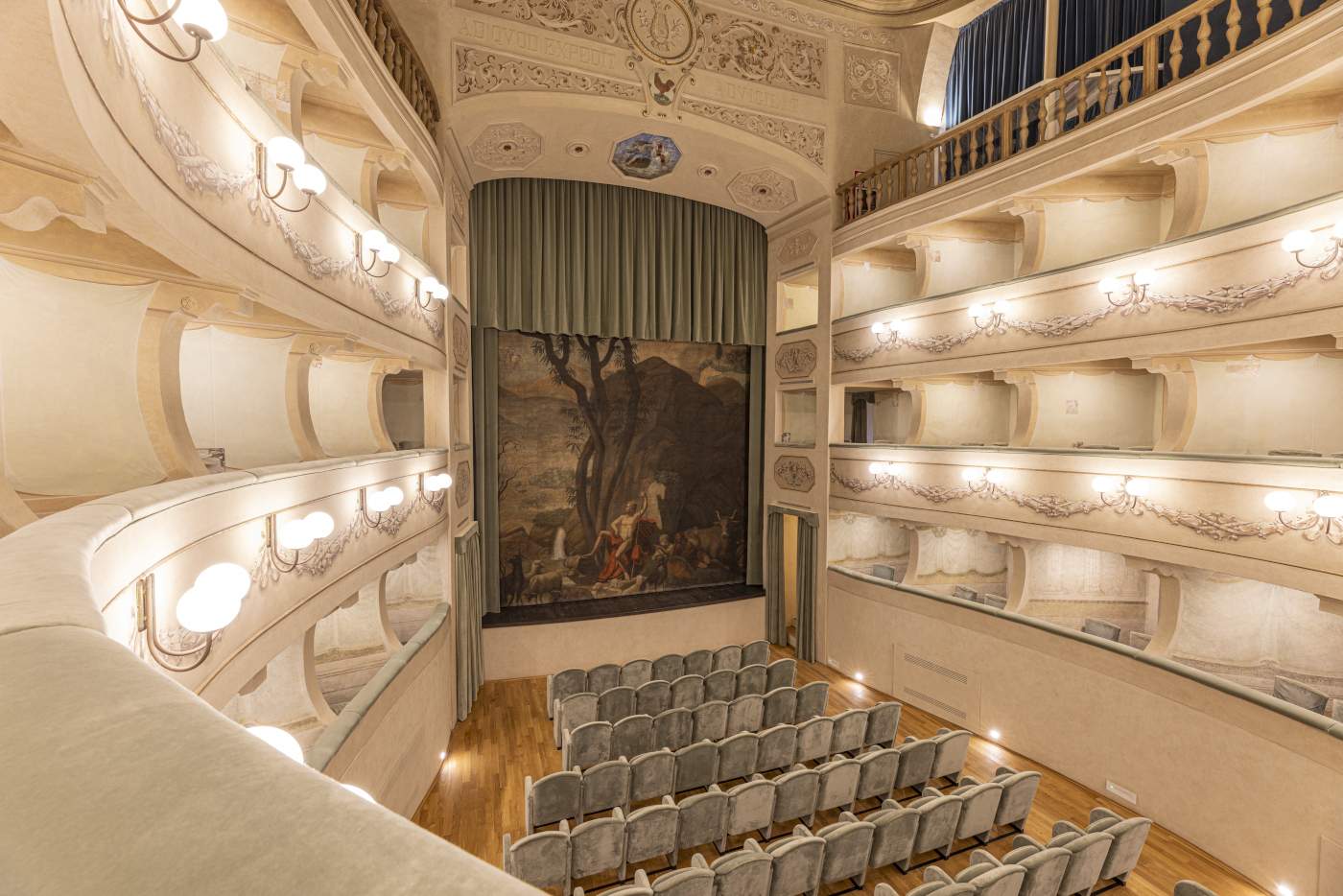Portoferraio, Napoleon's Theater reopens after restoration. Wall paintings in the boxes have emerged.
After 17 months of work, Portoferraio’s Teatro dei Vigilanti-Renato Cioni, also known as Il teatro di Napoleone (Napoleon’s theater), reopens to the public once again. Commissioned by Emperor Napoleon in the heart of the city’s historic Renaissance center, the theater has undergone restoration, upgrading and energy efficiency. The project, directed by architect Elisabetta Coltelli, not only restored the structure to its original splendor, but also allowed the discovery of wall paintings in the boxes, probably dating back to the Napoleonic era, which were previously unknown.
The Municipality of Portoferraio thus returns to the Elba Island community and visitors a place that has been a center of culture and entertainment for more than two centuries. The work, which had a total cost of 1,735,215.50 euros, was financed for 1,549,190.08 euros with funds from the PNRR and the rest with the Authority’s own funds.
The precarious state of preservation of the theater risked preventing the safe accessibility of a space that has always served the community. For this reason, a decision was made for a restoration involving the theater as a whole. Among the discoveries made during the work were some wall paintings from the probable Napoleonic era, inside the theater’s boxes. Their discovery and restoration allows a greater historical reinterpretation of the monument, an important testimony to the Napoleonic period. The work also brought to light the gilded cornices of the various tiers of boxes. The restoration was extended to the roof rose window, which can now be admired in its original brilliance.
Among the most significant interventions are the reopening of the original connection between the stage and the stalls, the replastering and painting of both the interior and the facades, the replacement of the exterior fixtures, the redoing of the roofing, the partial redoing of the electrical system and the fire-fighting system, the construction of the internet network and the anti-intrusion and video surveillance systems, the replacement of the stalls’ armchairs, the upholstery and the curtains of the proscenium that had been severely worn. In addition, the works include the resurfacing of the underground utilities and the paving of the adjacent staircase of the Falcone Fort, with the restoration of the original paving stones, and the completion of the missing parts in “beaten lime,” a typical type of the ancient city.
History of the theater
In the first half of the 17th century, the Governor of Portoferraio Orazio Borbone Marquis of Sorbello had an octagonal-shaped chapel erected at his own expense on the site of the structure to accommodate his burial. In 1714 the new Governor of Portoferraio Girolamo Piccolini had the chapel demolished and began work on the construction of a new church with a Greek-cross plan completed in 1718. The new building took the name Chiesa del Carmine, later stripped of its valuable furnishings and used as a simple military warehouse. The long-deconsecrated church remained in military use as a warehouse until 1814 when Napoleon Bonaparte came to Elba and proposed the construction of a small theater inside the building. The project was entrusted to architect Bargigli, who designed a horseshoe-shaped auditorium with 65 boxes, divided into four tiers topped by a gallery, with 16 first-rate boxes. Work began in July 1814. As requested by the Emperor, representatives of the city’s leading families soon created an academy, called “dei Fortunati,” to manage the structure. During implementation, however, they realized that the academy’s resources were insufficient for the continuation of the work. So they decided to auction off the boxes giving the right of first refusal to the academicians themselves and the city authorities.
In August 1814 the Piedmontese painter Vincenzo Antonio Revelli, who had been called by Napoleon to decorate his own residences at San Martino and Villa dei Mulini, was commissioned to execute the curtain, while for the ornaments and stuccoes the Livorno artist Compormi was commissioned. The theater was inaugurated on January 24, 1815, with a solemn reception attended by Napoleon’s mother Lucrezia Ramolino and sister Paolina. The theater directed by the Accademia dei Fortunati, which took the name of the Vigilanti, continued performances even after Napoleon’s departure on February 25, 1815. In 1922 the theater, which was in a precarious condition, underwent a renovation completed on April 4, 1923, which probably changed the stucco and decorations. On Feb. 20, 1937, the Academy entrusted the management to Mr. Baldasserini to turn it into a cinema-theater, which was opened on Oct. 9, 1937, and remained open until Jan. 6, 1952, when there was a final closure.
In 1974 the theater was purchased by the Municipality of Portoferraio. In 1979 renovation and restoration work began on the building with major interventions made in reinforced concrete on the monument’s load-bearing structures, which had been seriously degraded due to the prolonged abandonment of the theater.
Photo by Daniele Anichini
 |
| Portoferraio, Napoleon's Theater reopens after restoration. Wall paintings in the boxes have emerged. |
Warning: the translation into English of the original Italian article was created using automatic tools. We undertake to review all articles, but we do not guarantee the total absence of inaccuracies in the translation due to the program. You can find the original by clicking on the ITA button. If you find any mistake,please contact us.



























